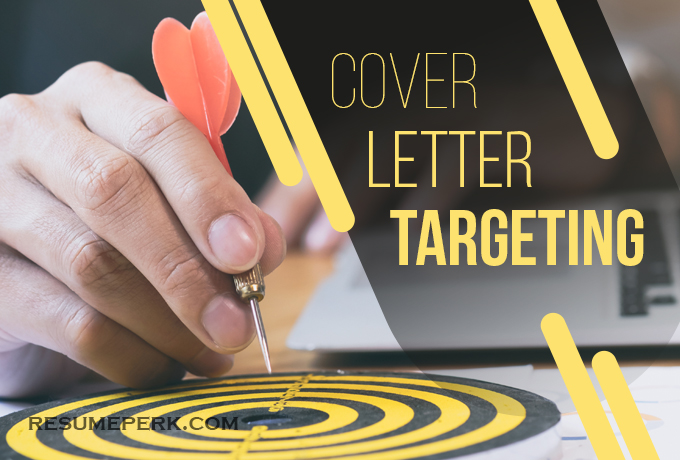Cover Letter Proofreaders: Tailoring Your Cover Letter

When posting the job on the internet, employers typically expect that you accompany a resume with a cover letter. And if you dislike writing them, it’s only because you don’t realize their hidden power. If you’ve never written cover letters before, or don’t know how to do it right, check the expert advice here: https://resumeperk.com/blog/how-to-write-winning-cover-letter-for-job-applications.
Writing tips from proofreader cover letter
Today, we are going to talk about proofreading cover letter and tailoring. Why tailoring? Because sending a cover letter that isn’t written for a certain job ad is like shooting without aiming a gun – the odds you’re going to hit where you want are incredibly little. It makes more sense to keep your focus sharp and know for sure where you want to hit, i.e. what job you want to get in the end. Take the full advantage of professional resume cover letter to win that interview – and here’s what exactly you can do:
- Complete your resume first
Have you spotted a dream job ad posted out there and feel the urge to apply as soon as possible, but aren’t sure what to compose first – a resume or cover letter? And, does the order of writing eventually matter? Technically it doesn’t, but there’s one important point. When you create a resume first, you reconstruct all you professional experience, brick by brick, line by line. You recollect the skills you forgot to mention, and the project that really made the difference. Basically, when writing a resume, you put your thoughts in order and realize what the strengths you have to offer to an employer are.
Composing application documents in a rush isn’t the best idea, though. When you’re short of time, it’s better to assign this task to resume writers by trade to avoid mistakes and weak, inconsistent writing. Send us your cover letter for editing and proofreading. - Create a cover letter template
To avoid puzzling over each and every cover letter you’ll have to write, create a basic template letter. You will modify it depending on the role you are aiming for. Why make this template? It will significantly save you time and effort when you re-write the letter again and again (believe me you will have to do so a lot until you find the job). Basically, the structure of a working cover letter remains as follows:- The first paragraphs indicating where you’d learned about the job, mentioning referees, and outlining your interests
- 1-2 paragraphs making it clear why you’ll be the best fit for getting their problems solved
- The closing paragraph to demonstrate secondary job-related aspects and show courtesy.
Thus, when you see a fresh posting, all you need to do is to research a little, change the core of this template, and apply. If you need cover letter template free, our website hosts a plenty of these – check the Samples section.
- Address a specific individual
In the era of Internet, it’s unforgivably rude to start your letter with “To whom it may concern”. Try researching the hiring manager’s name and address them directly; if your search failed, start with neutral “Dear Hiring Manager”. It’s just a trifle, but it’s the trifles that construct the very important first impression about you. - Give them grounded reasons to hire you
This is the longest part of your cover letter – and the most complex. Approaches and techniques to writing it may vary from formal reiteration of your loud successes to creative narratives sharing your love to the job. There’s no surefire recipe to crafting a cover letter that will urge the hiring manager call you immediately – unless you’re a professional cover letter writer with years of experience. Still, there are a few methods that work for most job-seekers – and all of them are about smart tailoring and anticipating the employer’s needs. Here’s what you can do:- Solve a problem – this one takes time and effort. Nevertheless, if you came across a really great opportunity, it’s totally worth it. The main reason why companies hire new employees is to get a certain problem solved – money saved, processes optimized, program developed, clients attracted, etc. Thus, by researching the company and understanding the nature of prospective role, you can anticipate the possible (or real) problem and develop the solution – even before they invited you for an interview. This is complex, but pays off almost always.
- Develop emotional connection – some companies, especially businesses of the new type, have unique corporate culture, outstanding products, impressive community involvement, or any other trait. Use it to highlight how company values resonate with you, tell the real story of your connection with the company’s products and services. Don’t lie, though, as it won’t help your career, and here’s the reasoning behind it: https://resumeperk.com/blog/is-it-worth-exaggerating-on-resume
- Share past record of success – behavioral approach to hiring assumes that the one who used to demonstrate success in similar tasks is likely to succeed doing this in the future. So, give them what they’re after. Showcase what you’ve achieved in the previous roles, giving figures when possible.
- Enrich your letter with keywords
If you are familiar with the basics of resume writing, then you are aware that a good resume needs to be keyword-enriched. This applies to cover letter as well. To keep the story short, the key thing you need to do is to read into job ad carefully and identify possible keywords. They typically include the software names, skills, and attributes (i.e. managing a team, supply chain, Adobe Photoshop, marketing campaigns, generating leads, etc.). Use the same language that is used in the posting. Not only is this done for the human eyes, but also to ensure that your cover letter passes an automated selection. The more keywords from a vacancy you use, the more targeted your cover letter will be, and the sooner a hiring manager will get their eye on it (this is how the ATS selection works). - Target the detail you’d like to share
As well as the resume, a good cover letter shouldn’t sound as the chronicles of your years in the workforce. It shouldn’t be long – 3-4 short paragraphs are more than enough (you can make it slightly longer if in an executive role). Moreover, here’s the golden rule: the experience that has nothing to do with the prospective role doesn’t belong to your cover letter. If you cannot transform something into your competitive advantage that would wow the hiring manager, remove this from the cover letter. It’s important to look from the employer’s prospective as you write, and decide what to include accordingly. - Create a really good piece of writing
One of the biggest mistakes applicants make is creating a cover letter that is highly formal or, in contrary, overly enthusiastic. Although poor writing skills and wrong tone of voice cannot downplay your proven competencies, they won’t make a great first impression as well. In addition to outlining your motivation, a cover letter serves as an example of your writing skills. That is, upon reading it, the employer will get an idea of your writing, organizational skills, motivation and personality.
A written text perfectly displays the way person thinks and acts. So, don’t limit your cover letter to plain reiteration of skills, facts and clichés. Engage them with your writing, make it strong yet emotional – not everyone does so these days, so take another change to stand out. Do not forget to end the letter correctly. - Give it a thorough proofread
Yes, it has nothing to do with tailoring. Still, error-free writing is highly important, so it’s definitely worth mentioning. After you’ve finished writing your letter, let some time pass and proceed to edit it and proofread. Read into it for a few times until you see everything looks the way it needs to look. You can always refer to cover letter proofreaders if you’re not sure, and get timely help to create resume online free.
Conclusion
I hope that I have convinced you to take extra time and tailor your cover letter for every job submission. It has been proved that tailored letters have several times higher response rate than cookie-cutter ones. Applying smart will help you reap the fruit faster than scamming in response to every opening that sounds somewhere near what you could do. Don’t persuade them, thrill them – this is what a good cover letter should do.
Need help with your cover letter writing?
If you still have questions left concerning cover letter writing or are simply short on time to do the writing on your own, consider getting professional counseling. The resume and cover letter writing of our company provide online resume help 24 hours a day and are at your disposal any time you need it. We staff writing professionals with BA or MA in English and Journalism, and they are ready to support your job search by providing you with an effective cover letter.
Interested? Don’t know where to start? Learn more about our pricing policy and terms of use, and feel free to contact us with any questions. We will also provide a free resume critique on your demand. Feel free to submit your cover letter for proofreading job.
Do you typically target your cover letter for job applications?
Recommended reading:
- How To Write Effective Email That Get Opened
- 12 Common Cover Letter Don'ts Everyone Should Know
- 3 Types of Cover Letters & When to Use Each
- How To Write An Email To Get A Job ? ResumePerk
- Relocation Cover Letter: Tips from Cover Letter Proofreader
- How To Write A Powerful Relocation Cover Letter - BEST TIPS!


